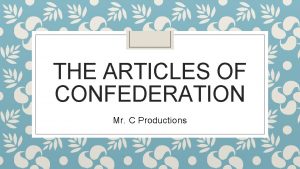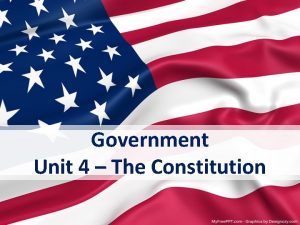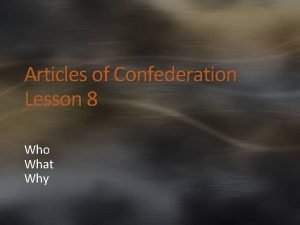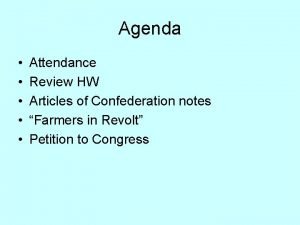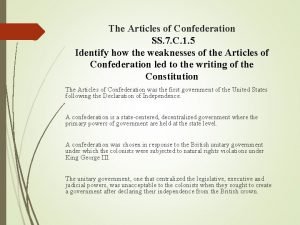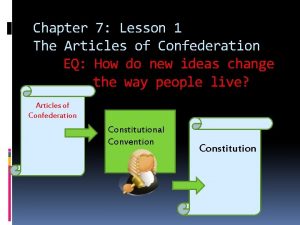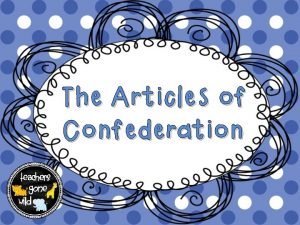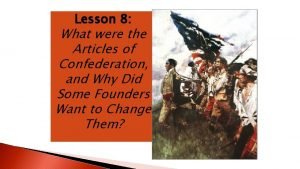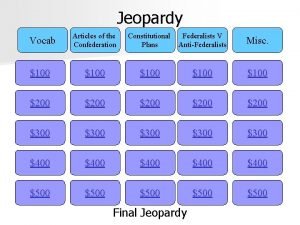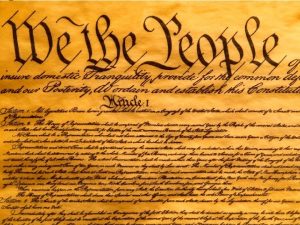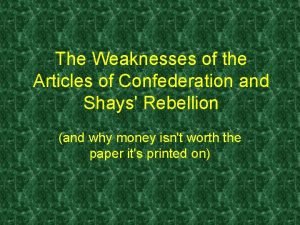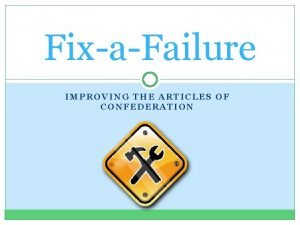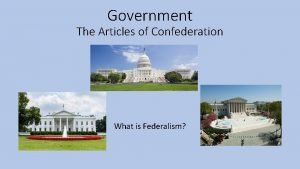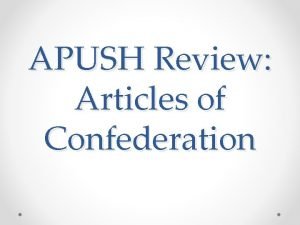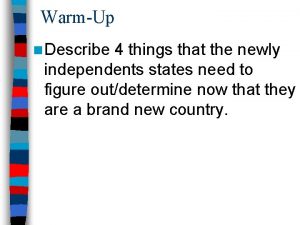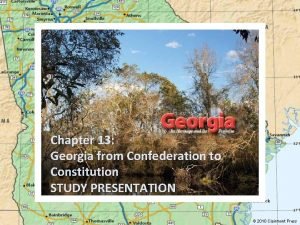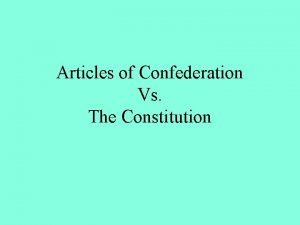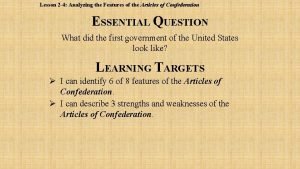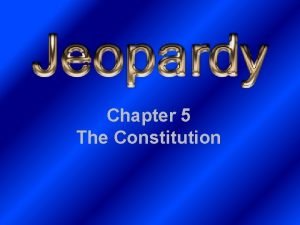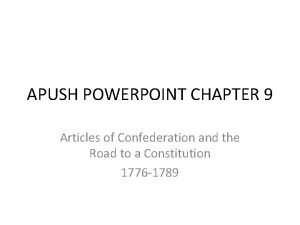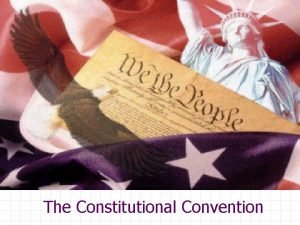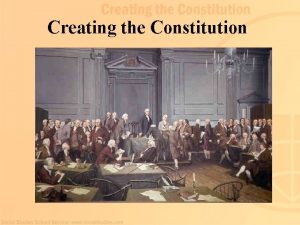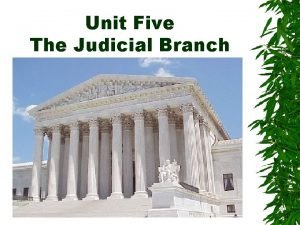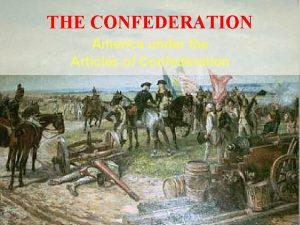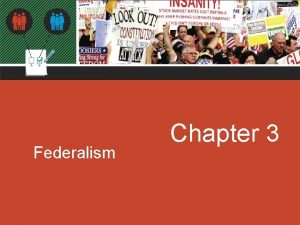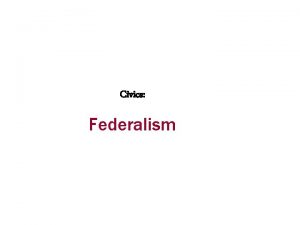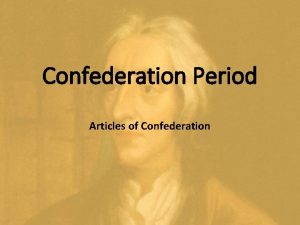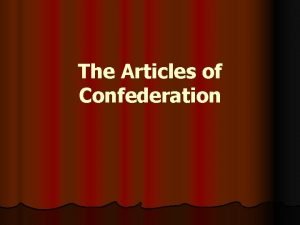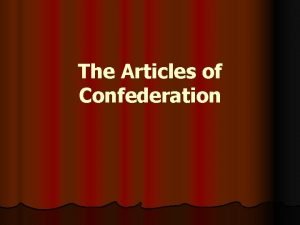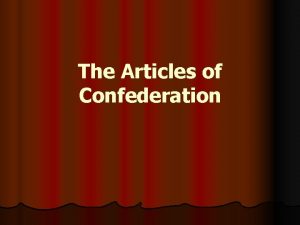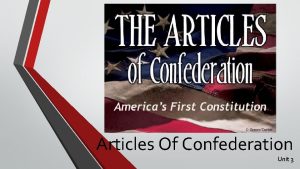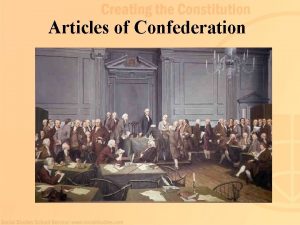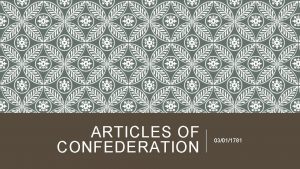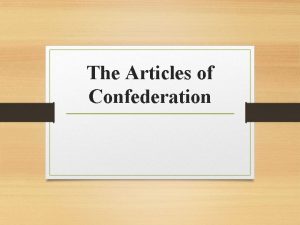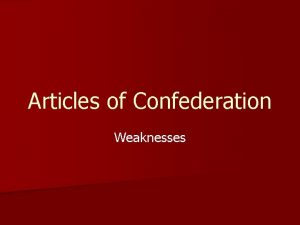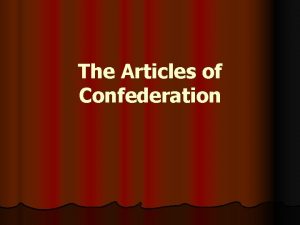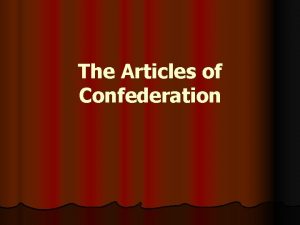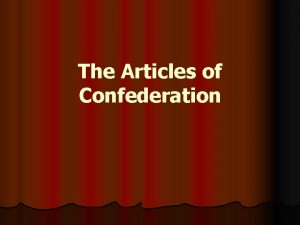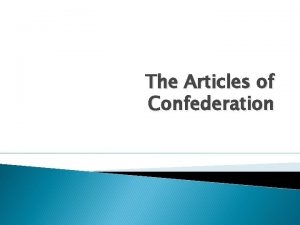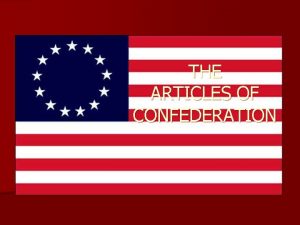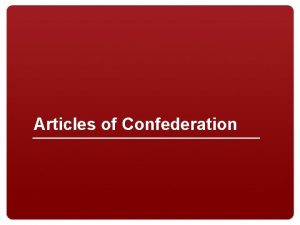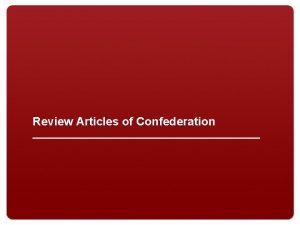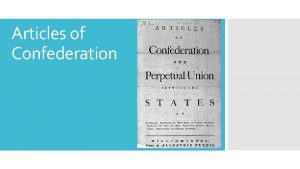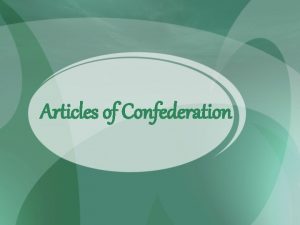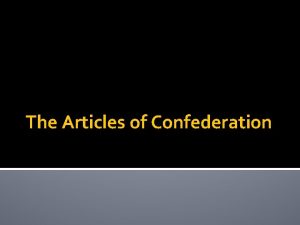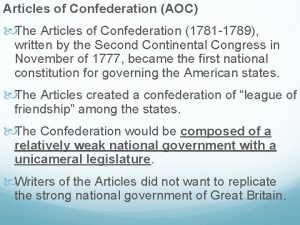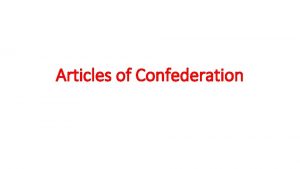Government The Articles of Confederation What is Federalism



























- Slides: 27

Government The Articles of Confederation What is Federalism?

Federal = National

Federalism = Power shared between the National Government and State Governments

What is a confederation or an anti-federalist? States have more power than the national government Why did our first constitution limit the powers of the national government?

We won the Revolution, now what? • After the colonies became independent, each state created its own government. • All the states set up republican forms of government. • In a republic, people choose representatives to govern them.

The Articles of Confederation 1777 • 2 nd Continental Congress created the first constitution (plan for a govt. ) • National government was a weak confederation (loose alliance) of states • The confederation had only one branch of govt: a unicameral congress • Each state had one vote

Placard Feature (Weakness) Why This Was Included/Excluded in the A. O. C. Possible Future Problems A The government had no chief executive B New laws needed to be approved by 9 of the 13 states C Congress did not have the power to tax its citizens D Congress did not have the power to draft men into the Continental Army E The government had no national court system F Any amendments to the Articles must be approved by all states G Congress did not have the power to collect state debts H Congress did not have the power to settle disputes among the states

Placard Feature (Weakness) Why This Was Included/Excluded in the A. O. C. Possible Future Problems A Did not want to have another The government had Lack of leadership for the powerful executive like King no chief executive government and the people. George III. B New laws needed to be approved by 9 of the 13 states C Congress did not have Fear of being unfairly taxed by The government didn’t have the power to tax its the government, as they had the funds to operate citizens been under British rule. effectively. D Congress did not have Fear of a strong military that the power to draft may be used to take away men into the people’s rights. Continental Army E The government had Fear of a national court Disputes between states could no national court system that could be unfair to not be settled fairly. system the rights of the states. F Any amendments to Wanted the states to have a the Articles must be fair and equal say in shaping approved by all states of the government. G Congress did not have Fear of a strong government The government didn’t have the power to collect that could force states to pay the funds to operate state debts for things they didn’t want. effectively. H Congress did not have Wanted states to have the power to settle power to resolve problems disputes among themselves. states Difficult to get nine states to Wanted to protect individual agree on a new law. states’ power. Fear of a strong Government accomplished central government. very little. Left the country vulnerable to attack. Nearly impossible to make changes to the Articles. The states became increasingly disunited. As we can see, the Articles of Confederation had many potential problems. The goal of the Founding Fathers was to prevent a strong monarch or king from having absolute power. Instead they formed a government with too little power.

Why did the Articles of Confederation fail? 1) Lack of a common currency Americans carried money from the federal government, state government, and foreign nations

Why did the Articles of Confederation fail? • 2. Congress could NOT levy (raise) taxes on the people and could only ask for money from the states. • U. S. is in debt 27 million after the war. Would you give the government money if you didn’t have to? Because of this, we are unable to pay our debts Examples of debt: -The U. S. owed money to France, Holland, and Spain for loans made during the Revolutionary War. -The U. S. had not paid many of their own soldiers!

Why did the Articles of Confederation fail? 3) No standing army The US lacked the military power to defend itself. Only had state militias.

Why did the Articles of Confederation fail? 4) No national court system States acted as individual countries and seldom agreed. Connecticut and Virginia almost went to war over land claims.

Why did the Articles of Confederation fail? 5) The nation did not have a president, or Chief Executive

Why did the Articles of Confederation fail? 6) Laws needed the approval of nine of the 13 states • Congress had just one house – unicameral • Very difficult for Congress to pass laws 7) To amend the document, you had to have unanimous (everyone’s) votes. • Congress had no power to regulate trade also

Why did the Articles of Confederation fail?

Despite its problems, there were three main accomplishments under the Ao. C: 1) Ratified the Treaty of Paris in 1783 2) Land Ordinance of 1785 3) Northwest Land Ordinance of 1787

Treaty of Paris 1783 Officially ends the war between the U. S. and Great Britain -U. S. a free and independent nation -Western border the Mississippi River -Each side agreed to pay their own debt USA!

Land Ordinance of 1785 • Law is still in effect to this day! • Organized newly acquired western lands • Laid pattern for orderly settlement

Land Ordinance of 1785 Congress surveyed the land into squares 6 miles on each side. These were called Townships. Each square was then divided into 36 sections, 1 mile on each side = 640 acres, at a cost of $1 per acre

The Northwest Territory Territories in what was then the northwest part of the United States One of the biggest accomplishments of the Articles of Confederation Today the territory makes up 5 U. S. states

What natural feature formed the western boundary of the United States in 1787? Though the war with England was over, there still was a region of dispute with Britain. Where was it? What other European power was still claiming land in North America in 1787?

How do territories become states? 5, 000 free males of voting age = Territory with non-voting representation in Congress 60, 000 free males of voting age = statehood -State constitution to be drafted, approved, and ratified -Right to trial by jury & -Freedom of religion guaranteed

What about slavery? Art. 6. There shall be neither slavery nor involuntary servitude in the said territory, otherwise than in the punishment of crimes whereof the party shall have been duly convicted: Provided, always, That any person escaping into the same, from whom labor or service is lawfully claimed in any one of the original States, such fugitive may be lawfully reclaimed and conveyed to the person claiming his or her labor or service as aforesaid. • The abolitionist movement began during the Revolution & had its 1 st victory of emancipation by law: Slavery was outlawed in the NW territory.

What happens to encourage change? Pivotal event: Shays’ Rebellion In 1786 -1787 Massachusetts farmer Daniel Shays (a veteran of the US Revolution) and his supporters attempted to storm a federal arsenal in Springfield, Massachusetts. Other conflicts soon followed across the state. -They were upset because farmer’s income decreased while taxes increased -Farmers who could not pay their debts had their farms taken away by the courts.

Shays’ Rebellion Shays continued his rebellion across western Massachusetts attacking different court houses and encouraging his supporters to attack tax collectors. The U. S. without an organized army was powerless. Massachusetts sent a militia to stop the rebellion.

Legacy of Shays’ Rebellion -The rebellion was eventually stopped, but Shays’ Rebellion convinced many people that the U. S. needed a new, stronger government. -The Articles of Confederation needed to be replaced!

1787 – the Constitutional Convention meets in Philadelphia, PA.
 Articles of confederation
Articles of confederation Articles of confederation vs constitution
Articles of confederation vs constitution Lesson 8 the articles of confederation
Lesson 8 the articles of confederation Articles of confederation fail
Articles of confederation fail Weaknesses of articles of confederation
Weaknesses of articles of confederation Chapter 7 lesson 1 answer key
Chapter 7 lesson 1 answer key Articles of confederation clipart
Articles of confederation clipart Problems with articles of confederation
Problems with articles of confederation Articles of confederation jeopardy
Articles of confederation jeopardy What is the main idea of the articles of confederation
What is the main idea of the articles of confederation Articles of confederation strengths
Articles of confederation strengths Articles of confederation apush
Articles of confederation apush Problems of articles of confederation
Problems of articles of confederation Articles of confederation
Articles of confederation Articles of confederation fail
Articles of confederation fail Articles of confederation apush
Articles of confederation apush Articles of confederation acrostic poem
Articles of confederation acrostic poem Articles of confederation characteristics
Articles of confederation characteristics Articles of confederation vs constitution
Articles of confederation vs constitution Political weaknesses of the articles of confederation
Political weaknesses of the articles of confederation Articles of confederation vs constitution chart
Articles of confederation vs constitution chart Strengths of the articles of confederation
Strengths of the articles of confederation Constitution vocabulary part 2
Constitution vocabulary part 2 Articles of confederation apush
Articles of confederation apush When was the great compromise
When was the great compromise Problems with the articles of confederation
Problems with the articles of confederation Articles of confederation
Articles of confederation Articles of confederation
Articles of confederation
